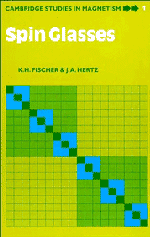Book contents
- Frontmatter
- Contents
- Preface
- 1 Introduction
- 2 Models, order parameters, and systems
- 3 Mean field theory I: Ising model, equilibrium theory
- 4 Introduction to dynamics
- 5 Mean field theory II: Ising dynamics
- 6 Mean field theory III: vector spins
- 7 Short-range interactions: low-temperature properties
- 8 Beyond mean field theory
- 9 Dynamics on many time scales
- 10 Specific heat, sound propagation, and transport properties
- 11 Competition between spin glass and ferromagnetic or antiferromagnetic order
- 12 One-dimensional models
- 13 Random field and random anisotropy
- 14 The physics of complexity
- 15 A short history of spin glasses
- References
- Index
5 - Mean field theory II: Ising dynamics
Published online by Cambridge University Press: 01 June 2011
- Frontmatter
- Contents
- Preface
- 1 Introduction
- 2 Models, order parameters, and systems
- 3 Mean field theory I: Ising model, equilibrium theory
- 4 Introduction to dynamics
- 5 Mean field theory II: Ising dynamics
- 6 Mean field theory III: vector spins
- 7 Short-range interactions: low-temperature properties
- 8 Beyond mean field theory
- 9 Dynamics on many time scales
- 10 Specific heat, sound propagation, and transport properties
- 11 Competition between spin glass and ferromagnetic or antiferromagnetic order
- 12 One-dimensional models
- 13 Random field and random anisotropy
- 14 The physics of complexity
- 15 A short history of spin glasses
- References
- Index
Summary
Most of our knowledge of spin glass dynamics is within MFT. This chapter is therefore devoted to a fairly complete review of the dynamics of the soft-spin SK model introduced in Section 4.3, focusing especially on the description of the AT line as a dynamical instability and on the dynamical description of broken ergodicity below it. Now we should note that the SK model is not a priori expected to give a good description of experimental reality in two and three dimensions: We are now quite sure that the two-dimensional EA model does not order at all except at zero temperature, and in the three-dimensional system the observed Tf is much lower than mean field theory would predict, indicating relatively weak order. Nevertheless, effects can be observed, in both experiments and Monte Carlo simulations, which can be identified in a qualitative way as something like an AT line. Therefore we spend some time in this chapter reviewing the comparison between MFT and these measurements.
As we have noted, the dynamical theory as formulated here does not require replicas. There is, however, a similarity between the dynamical formalism and the replica approach: The bond averaging will now lead to quantities which play a role analogous to the matrix qαβ of the static theory but have two time arguments instead of the two replica indices. In both cases, one uses the method of steepest descent, which is exact for the SK model.
- Type
- Chapter
- Information
- Spin Glasses , pp. 141 - 164Publisher: Cambridge University PressPrint publication year: 1991



